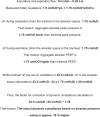Dynamic compliance in flow-controlled ventilation
- PMID: 34056674
- PMCID: PMC8164913
- DOI: 10.1186/s40635-021-00392-w
Dynamic compliance in flow-controlled ventilation
Conflict of interest statement
D. Enk: inventor of EVA and FCV technology (Ventrain, Tritube, Evone), royalties for EVA and FCV technology (Ventrain, Tritube, Evone), patent applications on minimizing dissipated energy and on calculating and displaying dissipated energy, (paid) consultant to Ventinova Medical. T. Barnes: patent application on calculating and displaying dissipated energy, (paid) consultant to Ventinova Medical.
Figures

References
-
- Barnes T, Enk D. Ventilation for low dissipated energy achieved using flow control during both inspiration and expiration. Trends Anaesth Crit Care. 2019;24(2):5–12. doi: 10.1016/j.tacc.2018.09.003. - DOI
Publication types
LinkOut - more resources
Full Text Sources
Other Literature Sources

